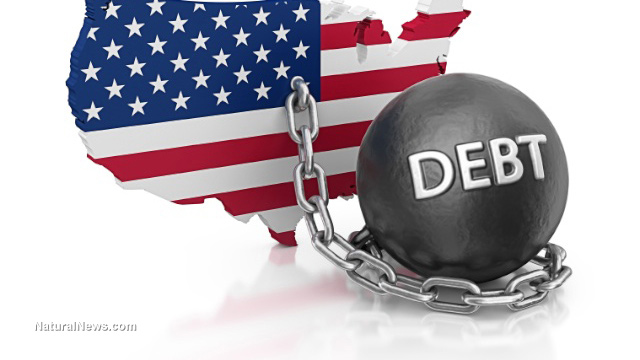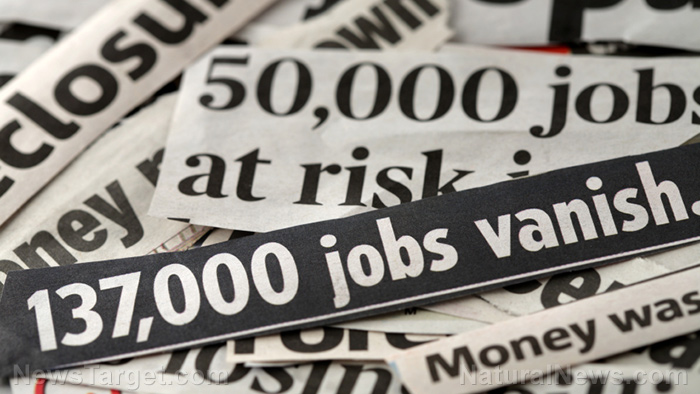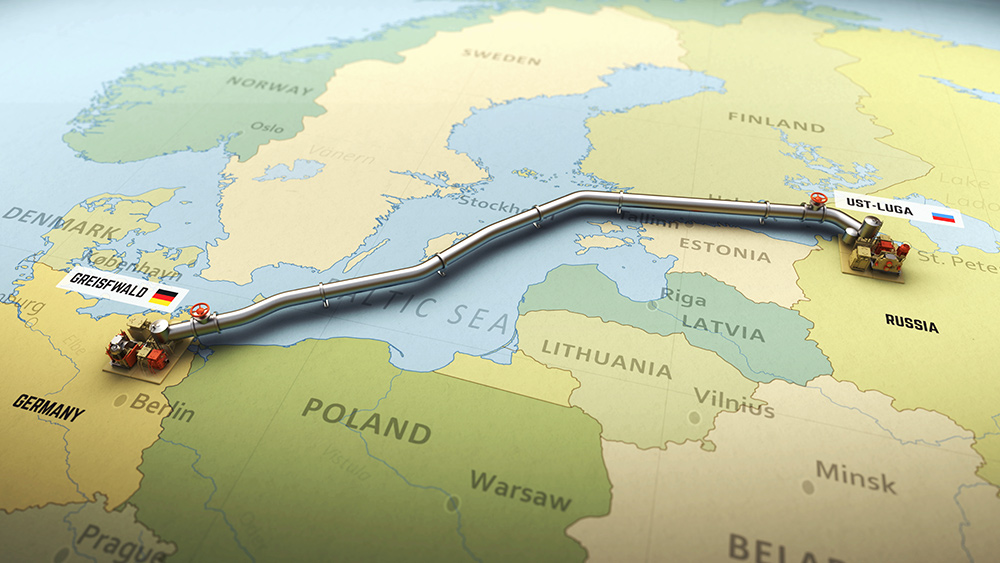Why the U.S. debt is unsustainable and is destroying the middle class
04/23/2024 / By News Editors

In a recent tweet, a talented financial analyst and investor stated: “The “debt is unsustainable” narrative has been around for 40 years plus. What’s astonishing to me is how the people who push this narrative never ask themselves, “Why has it been sustainable for so long?”.
(Article by Daniel Lacalle republished from Mises.org)
There is a widespread idea that the fiscal imbalances of a world reserve currency issuer would end in an Argentina-style bankruptcy. However, the manifestation of unsustainability did not even appear as drastic in Argentina itself. Hey, Argentina continues to exist, doesn’t it?
Excessive public debt is unsustainable when it becomes a burden on productive growth and leads the economy to constantly rising taxes, weaker productivity growth, and weaker real wage growth. However, the level of unsustainable accumulation of debt may continue to rise because the state itself imposes public debt on banks’ balance sheets and the state forces the financial sector to take all its debt as the “lowest risk asset.” However, law and regulation have merely imposed and forced this construct. Rising debt bloats the government’s size in the economy and erodes its growth and productivity potential.
Many diabetic and obese people continue to eat too much unhealthy food, thinking nothing has happened so far. That does not mean their eating habits are sustainable.
Those who ignore the accumulation of public debt tend to do so under the idea that nothing has happened yet. This is a reckless way of looking at the economy, a sort of “we have not killed ourselves yet; let us accelerate” mentality.
An ever-weaker private sector, weak real wages, declining productivity growth, and the currency’s diminishing purchasing power all indicate the unsustainability of debt levels. It becomes increasingly difficult for families and small businesses to make ends meet and pay for essential goods and services, while those who already have access to debt and the public sector smile in contentment. Why? Because the accumulation of public debt is printing money artificially.
When money is created in the private sector through the financial system, there is a process of wealth creation and productive money creation. The financial system creates money for projects that yield a genuine economic return. Some fail, others soar. That is the process of productive economic growth and progress. Only when the central bank manipulates interest rates, disguises the cost of risk, and increases the money supply to monetize unproductive deficit spending can it distort this process.
When the central bank wants to disguise the worsening solvency of fiscally imprudent governments, it does so by tampering with interest rates—making fiscally irresponsible governments’ borrowing cheaper—and artificially increasing the amount of currency in the system, monetizing public debt—a destructive process of money creation as opposed to the saving-investment function of banking.
When the fiscal position is unsustainable, the only way for the state to force the acceptance of its debt—newly created currency—is through coercion and repression.
A state’s debt is only an asset when the private sector values its solvency and uses it as a reserve. When the state imposes its insolvency on the economy, its bankruptcy manifests in the destruction of the purchasing power of the currency through inflation and the weakening of real wage purchasing capacity.
The state basically conducts a process of slow default on the economy through rising taxes and weakening the purchasing power of the currency, which leads to weaker growth and erosion of the middle class, the captive hostages of the currency issuer.
Of course, as the currency issuer, the state never acknowledges its imbalances and always blames inflation and weak growth on the private sector, exporters, other nations, and markets. Independent institutions must impose fiscal prudence to prevent a state from destroying the real economy. The state, through the monopoly of currency issuance and the imposition of law and regulation, will always pass on its imbalances to consumers and businesses, thinking it is for their own good.
The government deficit is not creating savings for the private economy. Savings in the real economy accept public debt as an asset when they perceive the currency issuer’s solvency to be reliable. When the government imposes it and disregards the functioning of the productive economy, positioning itself as the source of wealth, it undermines the very foundation it purports to protect: the standard of living for the average citizen.
Governments do not create reserves; their debt becomes a reserve only when the productive private sector economy within their political boundaries thrives and the public finances remain under control. The state does show its insolvency, like any issuer, in the price of the I.O.U. it distributes, i.e., in the purchasing power of the currency. Public debt is artificial currency creation because the state does not create anything; it only administers the money it collects from the same productive private sector it is choking via taxes and inflation.
The United States debt started to become unsustainable when the Federal Reserve stopped defending the currency and paying attention to monetary aggregates to implement policies designed to disguise the rising cost of indebtedness from unbridled deficit spending.
Artificial currency creation is never neutral. It disproportionately benefits the first recipient of new currency, the government, and massively hurts the last recipients, real wages and deposit savings. It is a massive transfer of wealth from the productive economy and savers to the bureaucratic administration.
More units of public debt mean weaker productive growth, higher taxes, and more inflation in the future. All three are manifestations of a slow burn default.
So, if the state can impose its fiscal imbalances on us, how do we know if the debt it issues is unsustainable? First, because of the units of GDP created, adding new units of public debt diminishes rapidly. Second, the erosion of the currency’s purchasing power persists and accelerates. Third, because productive investment and capital expenditure decline, employment may remain acceptable in the headlines, but real wages, productivity, and the ability of workers to make ends meet deteriorate rapidly.
Today’s narrative tries to tell us that nothing has happened when a lot has. The destruction of the middle class and the deterioration of the small and medium enterprise fabric in favor of a rising bureaucratic administration that consumes higher taxes but still generates more debt and deficits It does end badly. And all empires end the same way, with the assumption that nothing will happen. The currency’s acceptance as a reserve does come to an end. The persistent erosion of purchasing power and declining confidence in the legally imposed “lowest risk asset” are some of the red flags some are willing to ignore, maybe because they live off other people’s taxes or because they benefit from the destruction of the currency through asset inflation. Either way, it is profoundly anti-social and destructive, even if it is a slow detonation.
The fact that there are informed and intelligent investors who willingly ignore the red flags of weakening the middle class, declining purchasing power of the currency and deteriorating solvency and productivity shows why it is so dangerous to allow governments to maintain fiscal imprudence. The reason why government money creation is so dangerous is because the government is always happy to increase its power over citizens and blame them for the problems its policies create, presenting itself as the solution.
Can debt continue to rise? Of course. The gradual process of impoverishment and serfdom is relatively comfortable when the state can impose the use of the currency and force its debt into your pension by law and regulation. To think that it will last forever, and nothing will happen is not just reckless “accelerate, we have not crashed yet” mentality. It is ignoring the reality of money. Independent money, gold, and similar, solve this.
Read more at: Mises.org
Submit a correction >>
Tagged Under:
big government, bubble, collapse, currency crash, debt bomb, debt collapse, dollar demise, economic riot, economy, finance, finance riot, government debt, inflation, market crash, money supply, national debt, pensions, public debt, rigged, risk, Xpost
This article may contain statements that reflect the opinion of the author
RECENT NEWS & ARTICLES
COPYRIGHT © 2022 EconomicRiot.com
All content posted on this site is protected under Free Speech. EconomicRiot.com is not responsible for content written by contributing authors. The information on this site is provided for educational and entertainment purposes only. It is not intended as a substitute for professional advice of any kind. EconomicRiot.com assumes no responsibility for the use or misuse of this material. All trademarks, registered trademarks and service marks mentioned on this site are the property of their respective owners.



















